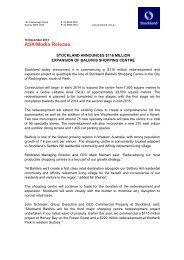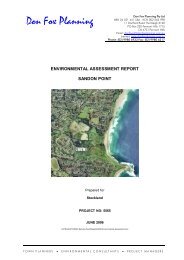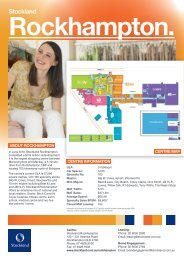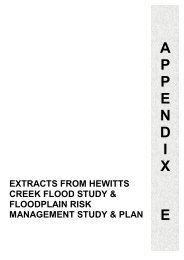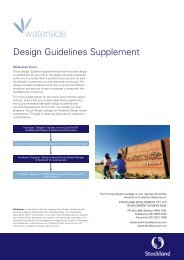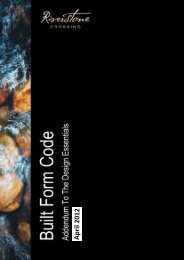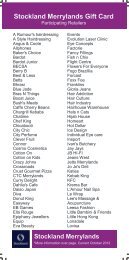Stockland Direct Retail Trust No.1
Stockland Direct Retail Trust No.1
Stockland Direct Retail Trust No.1
Create successful ePaper yourself
Turn your PDF publications into a flip-book with our unique Google optimized e-Paper software.
<strong>Stockland</strong> <strong>Direct</strong> <strong>Retail</strong> <strong>Trust</strong> No. 1 and its controlled entities<br />
Notes to the Consolidated Financial Statements<br />
For the Year Ended 30 June 2009<br />
2 Accounting estimates and<br />
assumptions (continued)<br />
(a) Key sources of estimation<br />
uncertainty (continued)<br />
Estimates of performance fee expense<br />
A performance fee is payable to the<br />
Responsible Entity if certain out performance<br />
is achieved by the consolidated entity. The fee<br />
is calculated on 2.5% of the gross value of the<br />
property on the calculation date calculated on<br />
a cumulative basis. The consolidated entity<br />
has provided for a performance fee of $Nil as<br />
at 30 June 2009. Refer to Note 21 for further<br />
details.<br />
The Responsible Entity determines the value of<br />
the performance fee to be provided based on<br />
the current property valuation and estimates<br />
regarding the likely sales proceeds on disposal<br />
of the consolidated entity’s property.<br />
The best evidence of the likely sales proceeds<br />
is the fair value of the property. Current prices<br />
in an active market for similar investment<br />
properties, leases and other contracts are the<br />
best indicator of fair value. Where such<br />
information is not available, the consolidated<br />
entity determines the property’s fair value<br />
within a range of reasonable fair value<br />
estimates. In making its judgement, the<br />
consolidated entity considers information from<br />
a variety of sources as described in Note 2(a)<br />
(i)–(iv) above.<br />
An estimate of the performance fee expense<br />
is then made factoring in the current fair value<br />
of the consolidated entity’s property and<br />
expectations regarding future property<br />
market volatility.<br />
Assumptions underlying the Responsible<br />
Entity’s estimates of performance fee<br />
expense<br />
The performance fee, if any, is recognised in<br />
the Income Statement on an accruals basis.<br />
The performance fee is calculated in<br />
accordance with the Constitution. This<br />
involves the assumptions set out below:<br />
The discounted cash flow approach applied<br />
for determining the fair value of the property<br />
usually includes assumptions in relation to<br />
current and recent investment property<br />
prices. If such prices are not available, then<br />
the fair value of investment properties is<br />
determined using assumptions that are mainly<br />
based on market conditions existing at each<br />
balance date.<br />
The principal assumptions underlying the<br />
Responsible Entity’s estimation of fair value are<br />
those related to the receipt of contractual<br />
rentals, expected future market rentals, void<br />
periods, maintenance requirements, and<br />
appropriate discount rates. These valuations<br />
are regularly compared to actual market yield<br />
data, and actual transactions by the<br />
consolidated entity and those reported by<br />
the market.<br />
The expected future market rentals are<br />
determined on the basis of current market<br />
rentals for similar properties in the same<br />
location and condition.<br />
It is assumed payment of the performance fee<br />
will occur in accordance with the Constitution<br />
and the projected life of the <strong>Trust</strong>.<br />
The consolidated entity has then applied an<br />
appropriate discount rate to reflect the<br />
projected life of the <strong>Trust</strong>.<br />
Assumptions underlying the Responsible<br />
Entity’s estimates of fair value of<br />
derivatives<br />
The fair value of derivatives is determined<br />
using a generally accepted pricing model<br />
based on a discounted cash flow analysis<br />
using assumptions supported by observable<br />
market rates. The determination of fair value of<br />
derivatives is described further in Note 20.<br />
3 Segment reporting<br />
The consolidated entity and the <strong>Trust</strong> operate<br />
solely in the business of investment<br />
management in Australia.<br />
<strong>Stockland</strong> <strong>Direct</strong> <strong>Retail</strong> <strong>Trust</strong> No. 1 June 2009 13



